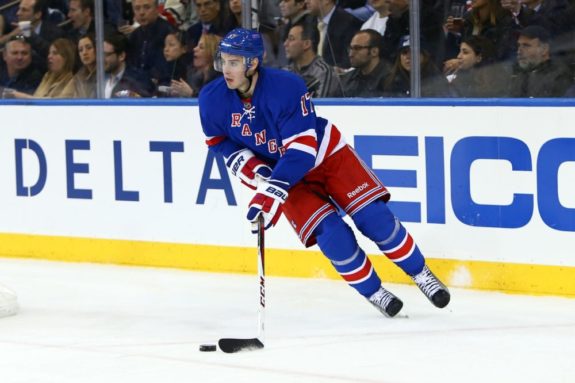Shockwaves were sent through the world of hockey when it was announced that Marian Gaborik was traded to the Columbus Blue Jackets on trade deadline day. The Rangers, who, at the time, were struggling to win games and put together consistent efforts, decided to trade the Slovakian scorer to Columbus in an attempt to rekindle some of the depth lost in the Rick Nash trade. In return, the Rangers acquired three young, NHL-caliber players — Derick Brassard, Derek Dorsett, and a young defenseman by the name of John Moore.

Moore, a first round pick back in 2009, was struggling to find a spot at the NHL level with the Blue Jackets, mainly due to a glut of other defensive prospects and players who began to emerge this season. Players like Dalton Prout, Tim Erixon (acquired by the Blue Jackets in the Nash trade), and David Savard allowed the Blue Jackets to move Moore in a trade for a proven goal scorer without it hurting the team significantly. While some may view this as the Blue Jackets “giving up” on Moore, or being disappointed in his development, I prefer to look at it like this: the only reason it was Moore that was moved, and not one of Prout/Nikitin/Savard, is because he is the player with the highest value and upside out of that group.

Gaborik had been struggling this year, but he is still a proven goal scorer, and is one season removed from finishing third in the league in goals. The Rangers needed value, player value, in return for Gaborik despite his struggles, and while many fans/insiders were wondering why the Rangers did not return a first round pick, I believe that acquiring a promising young player like John Moore negates the ‘need’ for a first. It’s not surprising that the Rangers targeted Moore. He fits the description of what the Rangers look for in young defensemen: size, puck moving capabilities, and mobility.
Moore is an acquisition that comes with short term benefits. The same could not be said of acquiring a first round pick. While this season has not gone very well for the Rangers, the current objective of the team is to compete this season, and Moore helps in achieving that goal more so than a pick. Moore is not just a short term asset, either, he is a long term asset, which makes this acquisition an excellent one for the Rangers, in my opinion. Especially with what Moore has shown thus far.
Moore has secured a spot on the Rangers defense, and has done nothing but impress the fans, management, and even the stubborn John Tortorella with his play.
“We’ve been fluctuating in the five and six position all year, but he’s come in and played real well for us,” Tortorella told Newsday. “He’s still a young guy, but what we’re trying to teach him, he’s picking up. The way he skates and the area he covers in that position, the onus is on us to teach him about positioning and how we play defense. He’s an interesting one.”
Since coming to the Rangers, Moore has played 11 games, produced five points (one goal, four assists), is a plus-seven, and is averaging a little over 13 minutes of ice time per game. The stats don’t tell the whole story, even though those numbers are fairly impressive for a third pairing defenseman.
The exciting aspect of Moore’s game is his physical presence. He is tall, at 6’3, and he is mobile. To go along with these physical gifts, Moore also has an excellent head on his shoulders, possesses a good first pass, and is an intelligent player on the ice. He has good offensive instincts and shows no hesitation to jump into the rush or pinch in the offensive zone. Moore, unlike some other aggressive defensemen, picks his spots rather beautifully. He doesn’t give up much, and even if he makes a bad decision, he has the speed to get back defensively and give himself a chance to break up the rush, much like Ryan McDonagh, the player that Tortorella compared Moore to in the above quote. You can see an example of Moore’s intelligence and superior decision making from the Rangers most recent game game against the Panthers.
http://youtu.be/jAZ35xA9rVo?t=1m15s
You can see the smarts and ability to read a developing play from Moore in that instance. That is merely one example of many, as Moore has been making plays like that since joining the Rangers. Obviously, with only 11 games under his belt, it is still very early in his Rangers’ career, but what Moore has shown in his short time here is nothing short of impressive. It’ll be interesting to see if Moore can manage to make these plays against tougher competition — Moore has already seen his ice time increase from under 10 minutes to 13:28 against the Panthers and 14:11 against the Devils. He has even been given some power play time in recent games. He hasn’t been afraid to use his booming shot, a shot that he hasn’t utilized all too often since making the jump to pro. It will only add another dimension to Moore’s game if he is able to successfully integrate his big shot into his current repertoire. Moore has even been showing off a nasty side to his game — he recently got into a fight with Florida Panthers’ forward Jack Skille, and won the bout rather easily. It shouldn’t be expected of Moore, but his overall game would become even more well-rounded if he could start to play with more of an edge.
Either way, the future is bright for John Moore and the Rangers. He has the tools to be a top-3 defenseman on the team, and with the way he has performed thus far, it looks as though Moore will be able to contribute to this Rangers defense now and in the future.